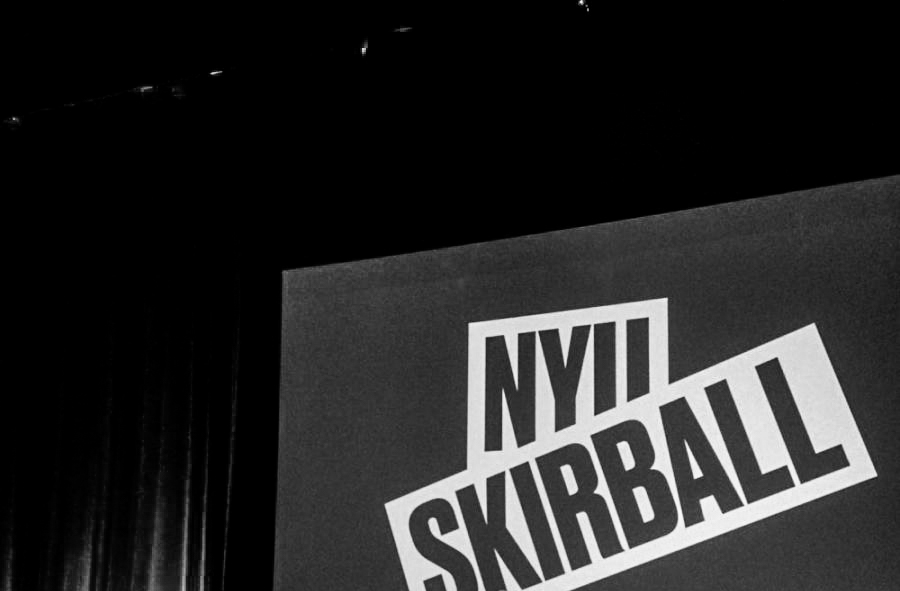Revisiting Gob Squad’s performance techniques in a time of remote theater
While it’s been more than a year without live theater, the enlivening experience of Gob Squad lives on.
NYU Skirball Center for the Performing Arts is located at 566 Laguardia Pl. In March 2018, the center hosted performances of Gob Squad’s ‘War and Peace.’ (Staff Photo by Alexandra Chan)
May 6, 2021
On a Thursday night in 2018, I felt emotionally stagnant. I decided to see Gob Squad’s rendition of “War and Peace” at NYU’s Skirball Center. I left the theater in tears and came back the next night to see it again.
The Berlin-based, German-English performance collective Gob Squad created over 38 performances and “live art events” since 1994. This past year, they were nominated for the Tabori Prize: Germany’s highest honor for the performing arts in the independent sector. Like all performers, they have been restricted by the COVID-19 pandemic. Their most recent production was a 12-hour livestream called “Show Me A Good Time,” which they broadcasted on June 20, 2020 using eight different performers in Berlin, London and Sheffield. Though they have worked with live video and various mediated broadcasting techniques, this was their first completely remote production.
When “Show Me A Good Time” aired on the summer solstice, I was emotionally wrecked. On top of everything that was happening in the greater world, I had found the most gigantic and pathetic baby bird I have ever seen, wet and screaming in the middle of the road that morning. I fed it worms from a plastic cup while driving for an hour in the direction of a wild animal rescue, only to get a call advising I put it back where I found it.
The show streamed from 6 p.m. to 6 a.m. Berlin time. Six of the eight performers also took turns as hosts of a sort, broadcasting out of the HAU Hebbel am Ufer theatre in Berlin. Each host stood on the stage, their back to the empty rows of seats, facing a tracking camera and a projector screen where a minimum of four other performers’ live footage was visible at all times. The host was responsible for initiating a full minute of mandatory synchronized laughter at half-past every hour. A running timer was visible at the bottom of the projector screen, as well as on the viewer’s watching device.
Gob Squad often works with windows and screens as a way of separating their performative events from the public. They recognize that the vocabulary of screens is natural to all audiences in the modern world, and it allows them to become active witnesses to their performative work.
Armed with headsets and cell phone cameras, the rest of the performers set out into the mostly empty streets of their respective cities. The audience watched as Johanna Freiburg urinated in a parking lot in front of the famously exclusive club Berghain. Tatiana Saphir pressed her naked chest against the window of a costume shop as the sun went down. Bastian Trost tried on and walked in another man’s shoes after finding an abandoned pair on a train platform. Sharon Smith gave her husband a haircut and made a pasta dinner for her children. Sarah Thom washed a car for ten minutes at a gloomy gas station. Simon Will spooned a reclined marble statue in a public fountain. He proceeded to invite unmasked people outside of closed bars or in Tempelhof airport to have conversations with other performers through his phone.
Though it did not feature in “Show Me A Good Time,” Gob Squad coined the term “Remote Acting” for a particular type of audience involvement. They prompt audience members turned performers with the improvised text directly through headphones while on stage. The speech of the audience in this method is mediated, and so the person who speaks is not necessarily the one who the text belongs to. The technical equipment dictates the manner of the performance and the bodies of the non-actors become vessels through which the content flows.
The aim of the entire performance was to ask the audience, each other and strangers on the street, the question of “What is a good time?” Gob Squad endeavors to position the viewer at the intersection of art, culture and history within the individual audience member’s own personal timeline of their relationship to the work, transforming them from a spectator into an involved member.
In their performance reader, Gob Squad describes their goal of creating a feeling of voyeurism in their audience: “There is greater intimacy with a stranger when you interact within an artificial frame—if you were just in the room with them and were speaking with them directly, you wouldn’t be as honest, it’s like being in an online chat room.”
It is pretty much what I am constantly asking for, to be shown a good time when I turn on a screen. In such an isolated moment of existence, to be transformed from a voyeur into a participant is such a gift.
It ended at 6 a.m. in Berlin. The sun was coming up, and the last host left the stage. The audience was presented with the ticking clock and a blurry live footage of two performers miming an embrace through a plate glass window, scored by the low haunting hum of a single synthesizer. “Show Me A Good Time” was an extraordinary marathon of intimacy. Following the performers felt like being let in on secret after secret — even as they transformed the streets of Berlin into a public stage.
The experience of a Gob Squad performance is totally disorienting, yet refreshing. The most succinct and appropriate description I can think of emerges from Virginia Woolf’s “To the Lighthouse” when she states that what she wanted to get hold of was that very jar on the nerves.
Email Perry Gregory at [email protected]
























































































































































